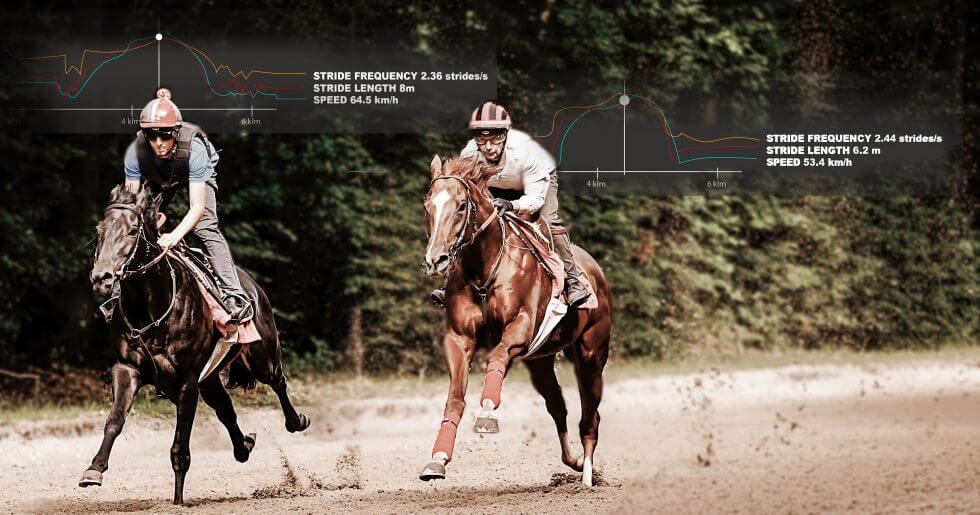Racehorse acceleration is one of the parameters to analyse when assessing the speed abilites of a horse.
The horse’s stride is the source of speed. Locomotion data analysis provides insight about how a horse achieves a specific speed. Thus, by analyzing the stride length and the stride frequency, we can identify the acceleration strategies of your racehorses: do they accelerate with their stride length rather than with their stride frequency?
In other words, to gain their maximum speed, do they prefer to lengthen their stride first, or repeat it and then lengthen it?
Racehorse acceleration Strategy – What are we talking about?
Acceleration strategy describes the way a horse accelerates during a race. Due to the terrain, the racing pace or the jockey’s choices, racehorses are subject to many changes in speed. They adapt their locomotion according to their preferences and what will be most efficient in terms of energy management.
Racehorse acceleration – How is it measured?
Acceleration is measured in m/s or m/s2. More simply, we try to understand how the speed evolves: in a given period of time, how much has this speed increased?
Example: maximum acceleration recorded during a training session of 0.54 m/s/s (parameter available in the Analytics tab). In one second, the horse was able to increase his speed by 0.54m/s, i.e. 0.54 x 3.6= 1.944 km/h. In 10s, the horse was able to increase his speed by 19,44 km/h.
Tracking acceleration over time allows us to analyze the evolution of a horse’s strength, which is even more relevant when training sprinters or preparing young horses for breeze ups.

Why analyze racehorse acceleration strategies?
There are many reasons to analyze acceleration strategies, especially during canter. Breathing at this gait follows the rhythm of the horse’s strides: inhalation during the projection phase, exhalation during the push. Thus, maintaining a high stride frequency requires an efficient cardiorespiratory system if one wishes to avoid premature breathlessness. On the contrary, the stride length triggers the muscles in depth, requires strength, but offers longer projection times allowing the horse to catch his breath for a longer time. Keeping a high stride length can allow the horse to keep his breath but can lead to muscle fatigue if the horse is not in a sufficient physical condition.
From a mechanical standpoint, if a horse prefers to increase his stride frequency first, this will allow him to reach maximum speed more quickly than a horse who prefers to unwind by increasing his stride lenth first.
By understanding your horse’s preferences, you can adapt the distance of the race and the choice of the start of the sprint finish. For example, a horse accelerating in stride frequency is theoretically more comfortable over short distances because the acceleration must be strong to reach top speed quickly, but does not need to be held for long.
Two concrete examples of racehorse acceleration strategies
In order to analyze a horse’s acceleration strategy, it is necessary to collect data from a training session where a very fast acceleration peak has been asked for. The higher the speed, the more reliable the data. We will analyze the example of two horses trained by the same trainer in a similar exercise.
Stride frequency acceleration – Fast acceleration for short distances
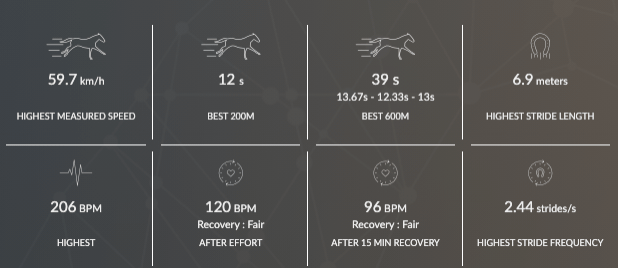
The horse performed a 1 hour and 04 minutes workout, during which a peak acceleration of nearly 60km/h (maximum recorded speed of 59.7 km/h) was recorded. To analyze the acceleration capacity, we will focus on the moment of the training when the horse has made a very fast acceleration peak, when he goes from 46,1 km/h to 59,7 km/h (highlighted areas on the picture).
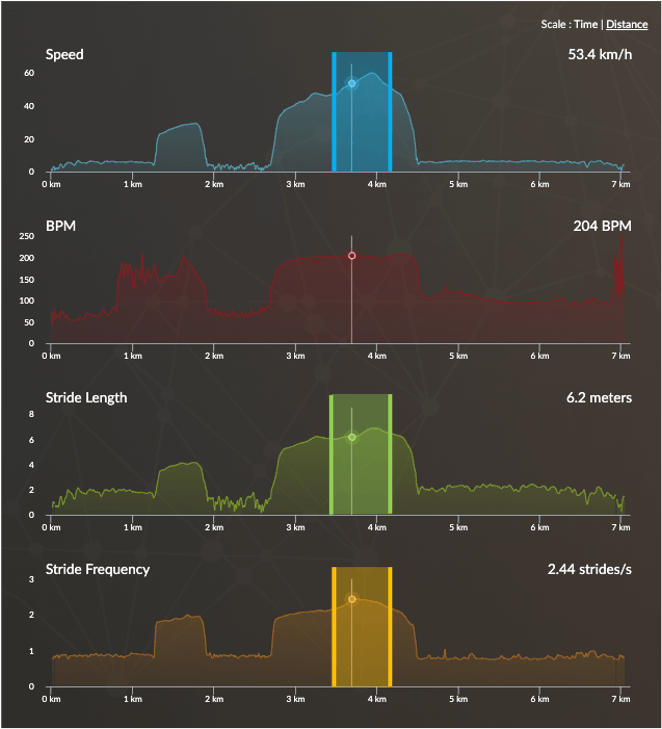
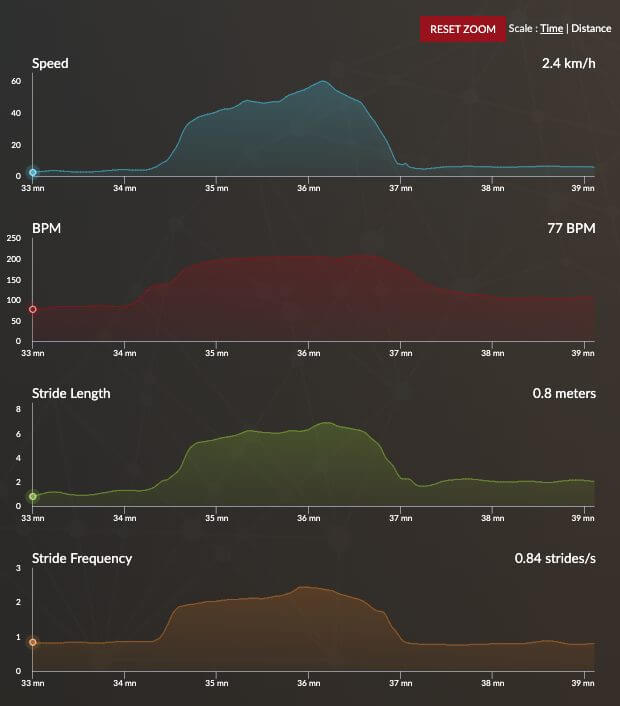
The first noticeable element is the peak increase in stride frequency when the horse is asked to accelerate. While the stride length remains stable, the horse increases his stride rhythm. This increases from 2.18 strides per second to 2.44 strides per second in a very short time. Then, only after having reached the desired stride frequency (remember that the horse adapts to changes in speed by adopting the stride length/stride frequency pair that he prefers), the horse progressively and insignificantly increases his stride length. His strides increase by 0.6m. We can therefore deduce that this horse accelerates with his stride frequency.
What does this tell us? His acceleration time is short because it is quicker for a horse to increase his strides pace than their size. However, this acceleration is difficult to sustain over time because the heart rate is based on the horse’s stride rate during canter. Therefore, in order to preserve the horse, the final sprint can be launched in the last few meters: the acceleration time is short. The moment when the sprint is launched becomes decisive in terms of acceleration strategy and race management.
Stride length acceleration – Slow acceleration adapted to longer distances
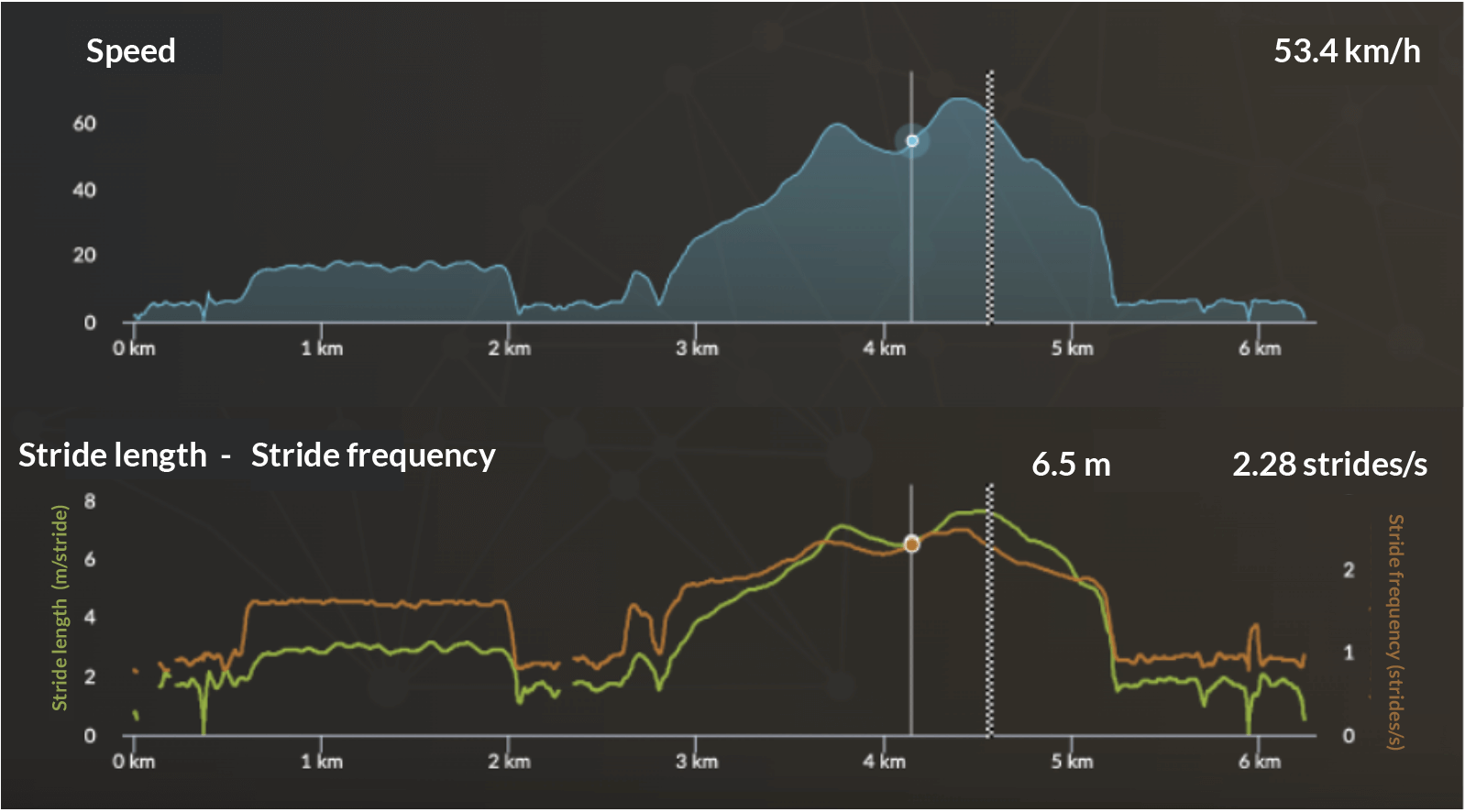
This horse has performed a gradual acceleration over 1500m during his training. To analyse his acceleration strategy, we will look at the data when the horse goes from 53.4 km/h to 61.1 km/h (highlighted areas in the picture). On the first hand, we can see on the orange curve that stride frequency varies very little. On the other hand, the green curve allows us to see a great increase in the stride length when the horse is asked to increase his speed. We can then assume this horse accelerates thanks to his stride length.
What does this tell us? His acceleration time will be longer, but this will save him energy since the heart rate matches the horse’s stride frequency. He is able to breathe for a longer time, and to inhale a greater volume of air. However, this horse will need to be launched from further away in the final sprint as his acceleration may take longer to build up.
Conclusion
Acceleration strategy analysis brings a better knowledge of each horse specificities and thus makes it possible to adapt race strategies and training to develop the strengths of each horse.
Key words : racehorse speed, racehorses maximal speed, acceleration strategies racehorse, equine technology, stride length racehorse, racehorse stride analysis

